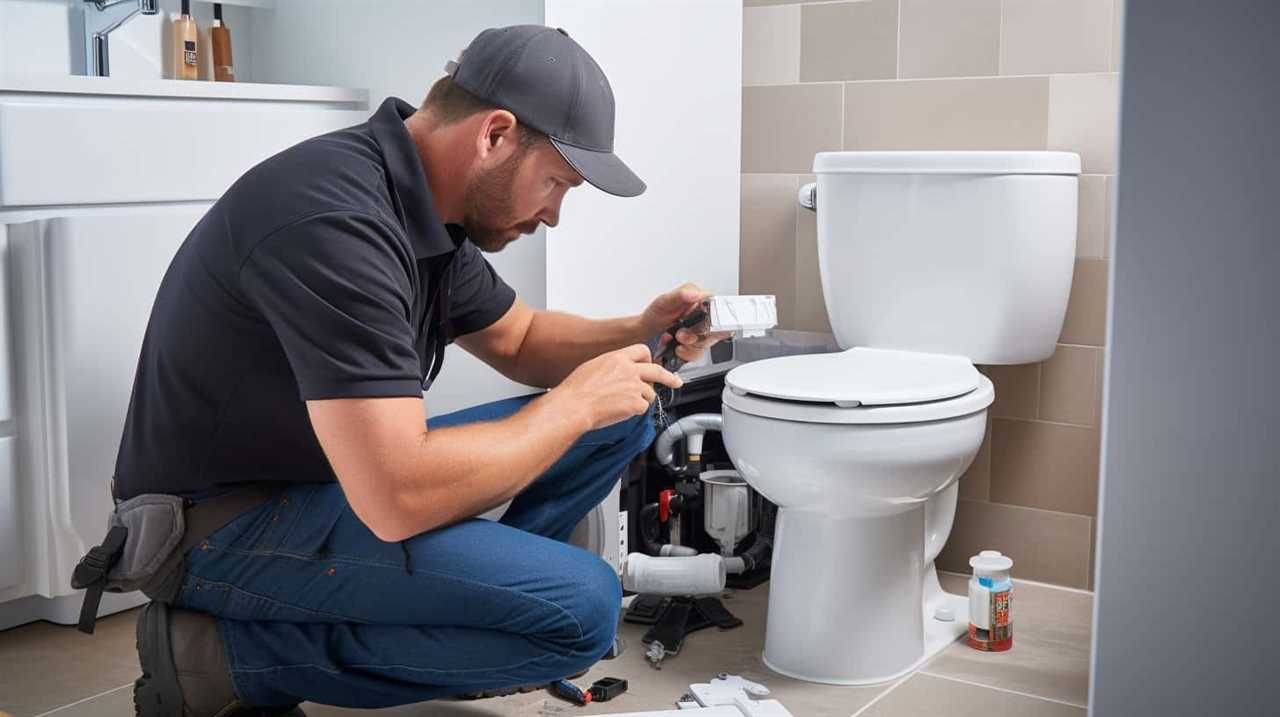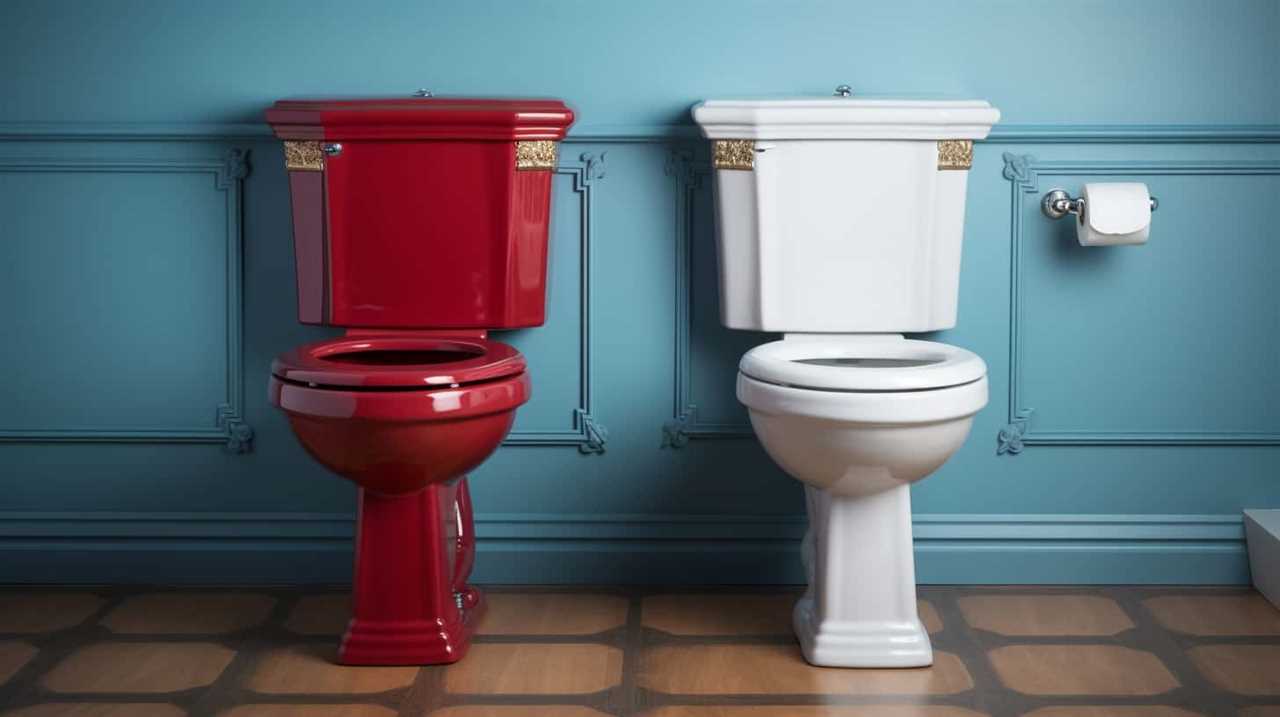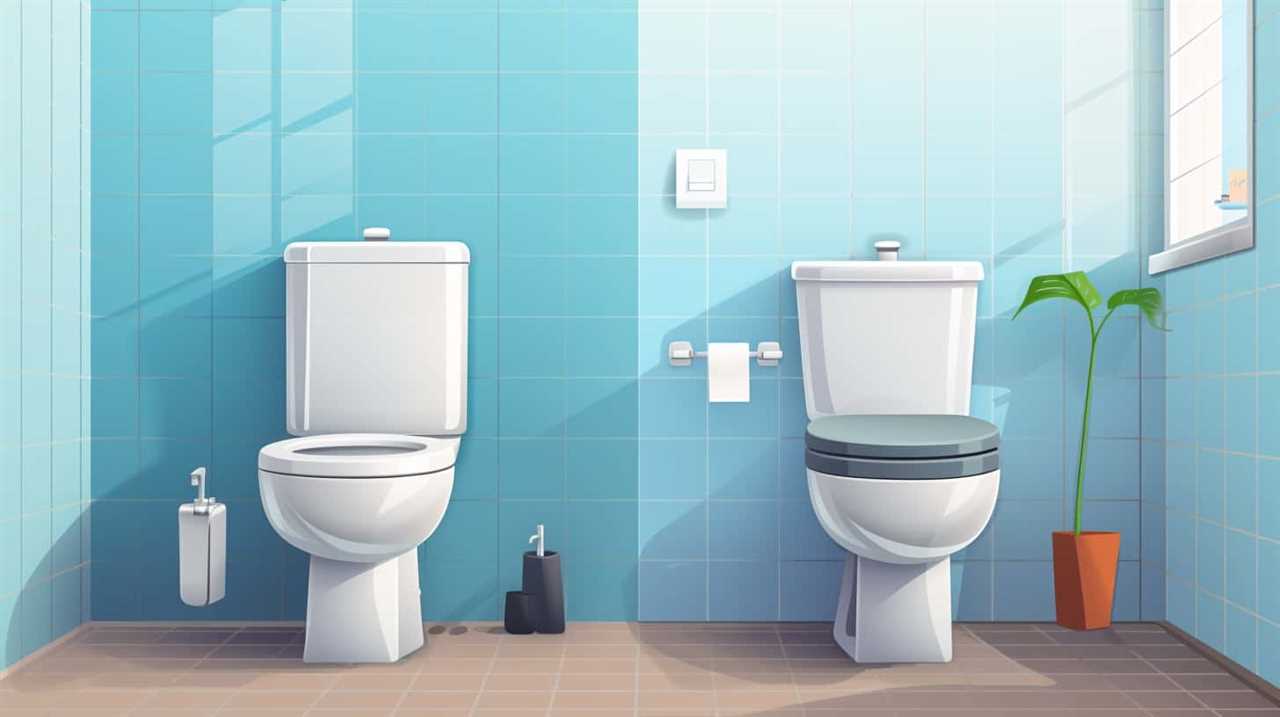We’ve all been there – standing in front of a stubbornly clogged toilet, wondering how to drain the tank and restore order to our bathroom.
Well, fret no more! In this article, we’ll guide you through the step-by-step process of draining a toilet tank with ease.
With the right tools and materials at hand, you’ll be able to shut off the water supply, remove excess water, and drain the remaining water from the tank like a true plumbing master.
Let’s get started!

Key Takeaways
- Gather necessary tools and materials such as rubber gloves, a bucket or large container, a clean cloth or sponge, and a safe area to place the toilet tank lid.
- Shut off the water supply by locating and turning the shut-off valve connected to the toilet tank clockwise.
- Flush the toilet and remove excess water using a sponge or towel to prevent mess or splashing.
- Disconnect the water supply line by turning off the water valve behind the toilet and using a wrench to loosen and remove the nut connecting the line to the tank.
Gather Necessary Tools and Materials
We will gather the necessary tools and materials to drain the toilet tank.
First, locate a pair of rubber gloves to protect your hands from any potential dirt or bacteria.
Next, retrieve a bucket or a large container that can hold the water from the toilet tank. This will prevent any mess or spillage during the process.
Additionally, have a clean cloth or sponge ready to wipe down the tank and remove any debris or residue.

Once you have these items, you can proceed to remove the toilet tank lid carefully. Place it in a safe area to avoid any accidental breakage.
This step will grant you access to the inside of the tank, allowing you to clean it thoroughly.
Shut off the Water Supply
To shut off the water supply, locate the shut-off valve connected to the toilet tank. This valve is usually located on the wall behind or near the toilet. Turn the valve clockwise until it’s fully closed.
Shutting off the water supply is an essential step in draining the toilet tank and performing maintenance tasks. It helps prevent water wastage and promotes water conservation during toilet tank maintenance.

Regular inspection and maintenance of water supply lines are important to ensure their proper functioning and prevent any potential leaks or damages. By shutting off the water supply and conducting regular inspections, you can identify and address any issues promptly, saving water and avoiding costly repairs.
Flush the Toilet and Remove Excess Water
After shutting off the water supply, it’s important to flush the toilet and remove any excess water. This step is crucial to ensure that the toilet tank is fully drained before proceeding further. To flush the toilet, simply press and hold the flush lever until all the water is drained from the tank and the bowl. If there’s excess water remaining in the tank, it can be removed using a sponge or a towel. Gently soak up the water, making sure not to leave any behind. This will prevent any splashing or mess when disconnecting the water supply line.
Now that the toilet is flushed and excess water is removed, we can move on to the next step of disconnecting the water supply line.
But before we do that, it’s worth mentioning a few tips for preventing toilet tank leaks. Regularly inspect the tank for any cracks or signs of damage. Additionally, avoid flushing items that can cause clogs, such as excessive toilet paper or non-flushable items. By taking these precautions, you can minimize the risk of toilet tank leaks and ensure the proper functioning of your toilet.

Disconnect the Water Supply Line
To disconnect the water supply line, turn off the water valve located behind the toilet. This step is crucial for toilet tank maintenance and troubleshooting water supply issues.
Once the water valve is shut off, follow these steps to safely disconnect the water supply line:
- Locate the nut connecting the water supply line to the toilet tank.
- Use a wrench to loosen the nut in a counterclockwise direction.
- Once the nut is loose, carefully pull the water supply line away from the toilet tank.
- Place a towel or bucket underneath to catch any remaining water that may drip from the line.
- Inspect the water supply line for any signs of damage or wear.
- If necessary, replace the water supply line with a new one to prevent future leaks or issues.
Drain the Remaining Water From the Tank
Once the water supply line is disconnected, we can proceed to drain the remaining water from the tank. To do this, locate the valve at the bottom of the toilet tank. This is typically called the flush valve or the flusher valve. Turn the valve counterclockwise to open it and allow the water to flow out. You may need to use a wrench or pliers to loosen it if it’s difficult to turn. Be careful not to force it too much as it could damage the valve.
As the water drains, you can use a sponge or a towel to remove any remaining water from the tank and dry it completely. This step is important before removing stubborn stains or replacing the toilet tank components.

Frequently Asked Questions
How Can I Determine if My Toilet Tank Needs to Be Drained?
To determine if our toilet tank needs draining, we look for signs such as slow flushing, water discoloration, or foul odor. Efficiently draining a toilet tank involves turning off the water supply, flushing to remove any remaining water, and using a sponge or towel to soak up any remaining water.
Can I Use Any Type of Container to Collect the Excess Water From the Tank?
Yes, we can use alternative containers to collect the excess water from the toilet tank. However, it is important to ensure proper water drainage to prevent any potential damage or overflow.
Is It Necessary to Shut off the Water Supply Before Draining the Toilet Tank?
It is necessary to shut off the water supply before draining the toilet tank. Regular maintenance of the tank has benefits such as preventing leaks and reducing water waste. Not shutting off the supply can lead to water damage and potential flooding.
How Often Should I Drain My Toilet Tank?
Toilet tank maintenance is essential for optimal performance. Signs of a full toilet tank include slow flushing and water leaks. It is recommended to drain the toilet tank every 6-12 months to prevent buildup and ensure proper functionality.

Are There Any Safety Precautions I Should Take While Draining the Tank?
When draining the toilet tank, it is important to take safety precautions. Ensure you have the proper equipment, such as gloves and goggles, to protect yourself from any potential hazards.
Conclusion
In just a few simple steps, you can easily drain your toilet tank like a pro! With the right tools and materials, shutting off the water supply, flushing and removing excess water, disconnecting the water supply line, and draining the remaining water from the tank becomes a breeze.
Say goodbye to any worries about a flooded bathroom and hello to a smoothly operating toilet. Give it a try and see the magic unfold before your eyes!










